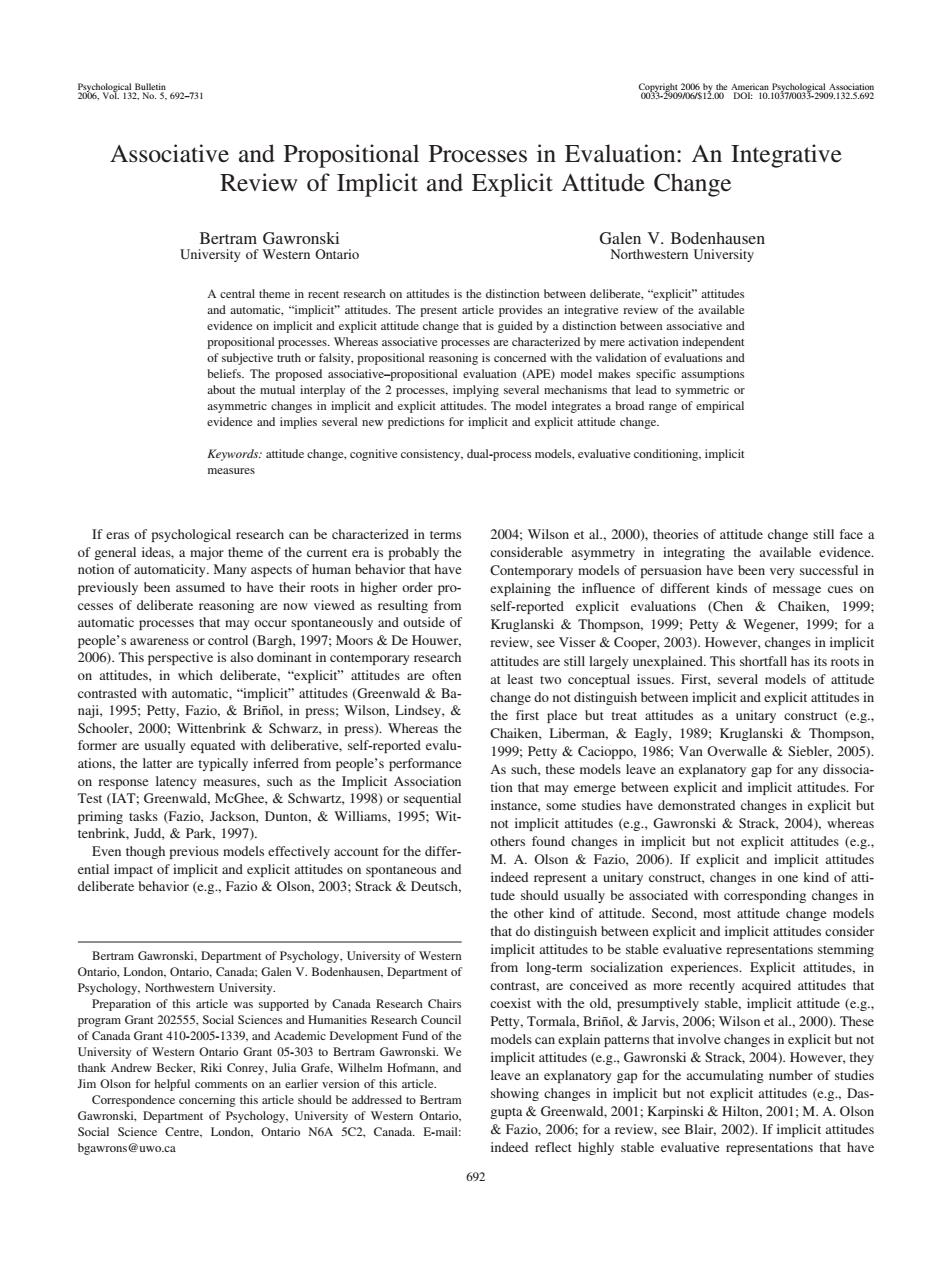正在加载图片...

2m- Associative and Propositional Processes in Evaluation:An Integrative Review of Implicit and Explicit Attitude Change entral theme ine distin n delibe de The pres icle pro des an Wherea re cha by picitandcpittedrangeofempice of. Contemporary mo odels of persuasion have been very successful in smd to e the roots in higl eview.see Visser&Cooper,2003).However,changes in implici on attitudes in which deliberate,.“explicit”attitudes 19g9 ct (e.g onk&Sch Petty&Cacioppo 2005 ald Mo hen g tas d Jac Dunton,&Williams,1995:Wit have demons els effectively account for the differ anges inc ated wit he othe kind of a change t long-term ization experien hology.Nor University. 1202 d Hu Tormala.Brinol.&Jarvi s.2006:Wilson et al.2000).Th is tha ski.W k20 Jim for helpful comm p for the ace cumulating number of st anges L:l (eg &Fazio.2006:for a rey s Blair,202).If implicit attitudes bgawrons@uwo.ca ndeed reflect highly stable evaluative representations that hav 692Associative and Propositional Processes in Evaluation: An Integrative Review of Implicit and Explicit Attitude Change Bertram Gawronski University of Western Ontario Galen V. Bodenhausen Northwestern University A central theme in recent research on attitudes is the distinction between deliberate, “explicit” attitudes and automatic, “implicit” attitudes. The present article provides an integrative review of the available evidence on implicit and explicit attitude change that is guided by a distinction between associative and propositional processes. Whereas associative processes are characterized by mere activation independent of subjective truth or falsity, propositional reasoning is concerned with the validation of evaluations and beliefs. The proposed associative–propositional evaluation (APE) model makes specific assumptions about the mutual interplay of the 2 processes, implying several mechanisms that lead to symmetric or asymmetric changes in implicit and explicit attitudes. The model integrates a broad range of empirical evidence and implies several new predictions for implicit and explicit attitude change. Keywords: attitude change, cognitive consistency, dual-process models, evaluative conditioning, implicit measures If eras of psychological research can be characterized in terms of general ideas, a major theme of the current era is probably the notion of automaticity. Many aspects of human behavior that have previously been assumed to have their roots in higher order processes of deliberate reasoning are now viewed as resulting from automatic processes that may occur spontaneously and outside of people’s awareness or control (Bargh, 1997; Moors & De Houwer, 2006). This perspective is also dominant in contemporary research on attitudes, in which deliberate, “explicit” attitudes are often contrasted with automatic, “implicit” attitudes (Greenwald & Banaji, 1995; Petty, Fazio, & Brin˜ol, in press; Wilson, Lindsey, & Schooler, 2000; Wittenbrink & Schwarz, in press). Whereas the former are usually equated with deliberative, self-reported evaluations, the latter are typically inferred from people’s performance on response latency measures, such as the Implicit Association Test (IAT; Greenwald, McGhee, & Schwartz, 1998) or sequential priming tasks (Fazio, Jackson, Dunton, & Williams, 1995; Wittenbrink, Judd, & Park, 1997). Even though previous models effectively account for the differential impact of implicit and explicit attitudes on spontaneous and deliberate behavior (e.g., Fazio & Olson, 2003; Strack & Deutsch, 2004; Wilson et al., 2000), theories of attitude change still face a considerable asymmetry in integrating the available evidence. Contemporary models of persuasion have been very successful in explaining the influence of different kinds of message cues on self-reported explicit evaluations (Chen & Chaiken, 1999; Kruglanski & Thompson, 1999; Petty & Wegener, 1999; for a review, see Visser & Cooper, 2003). However, changes in implicit attitudes are still largely unexplained. This shortfall has its roots in at least two conceptual issues. First, several models of attitude change do not distinguish between implicit and explicit attitudes in the first place but treat attitudes as a unitary construct (e.g., Chaiken, Liberman, & Eagly, 1989; Kruglanski & Thompson, 1999; Petty & Cacioppo, 1986; Van Overwalle & Siebler, 2005). As such, these models leave an explanatory gap for any dissociation that may emerge between explicit and implicit attitudes. For instance, some studies have demonstrated changes in explicit but not implicit attitudes (e.g., Gawronski & Strack, 2004), whereas others found changes in implicit but not explicit attitudes (e.g., M. A. Olson & Fazio, 2006). If explicit and implicit attitudes indeed represent a unitary construct, changes in one kind of attitude should usually be associated with corresponding changes in the other kind of attitude. Second, most attitude change models that do distinguish between explicit and implicit attitudes consider implicit attitudes to be stable evaluative representations stemming from long-term socialization experiences. Explicit attitudes, in contrast, are conceived as more recently acquired attitudes that coexist with the old, presumptively stable, implicit attitude (e.g., Petty, Tormala, Brin˜ol, & Jarvis, 2006; Wilson et al., 2000). These models can explain patterns that involve changes in explicit but not implicit attitudes (e.g., Gawronski & Strack, 2004). However, they leave an explanatory gap for the accumulating number of studies showing changes in implicit but not explicit attitudes (e.g., Dasgupta & Greenwald, 2001; Karpinski & Hilton, 2001; M. A. Olson & Fazio, 2006; for a review, see Blair, 2002). If implicit attitudes indeed reflect highly stable evaluative representations that have Bertram Gawronski, Department of Psychology, University of Western Ontario, London, Ontario, Canada; Galen V. Bodenhausen, Department of Psychology, Northwestern University. Preparation of this article was supported by Canada Research Chairs program Grant 202555, Social Sciences and Humanities Research Council of Canada Grant 410-2005-1339, and Academic Development Fund of the University of Western Ontario Grant 05-303 to Bertram Gawronski. We thank Andrew Becker, Riki Conrey, Julia Grafe, Wilhelm Hofmann, and Jim Olson for helpful comments on an earlier version of this article. Correspondence concerning this article should be addressed to Bertram Gawronski, Department of Psychology, University of Western Ontario, Social Science Centre, London, Ontario N6A 5C2, Canada. E-mail: bgawrons@uwo.ca Psychological Bulletin Copyright 2006 by the American Psychological Association 2006, Vol. 132, No. 5, 692–731 0033-2909/06/$12.00 DOI: 10.1037/0033-2909.132.5.692 692